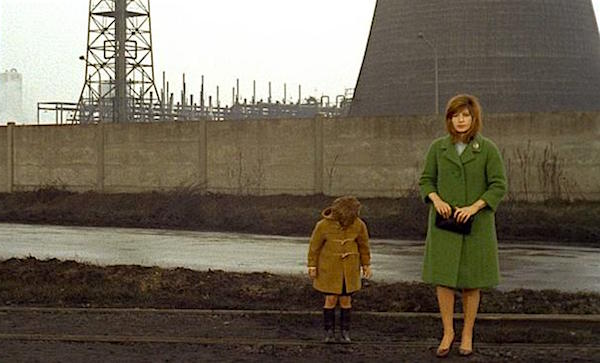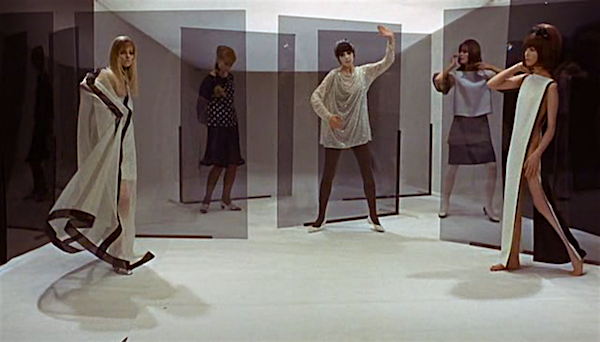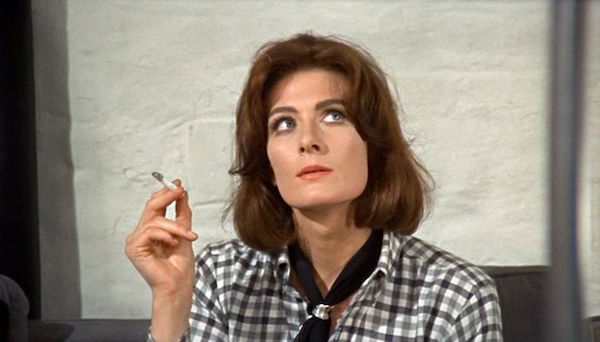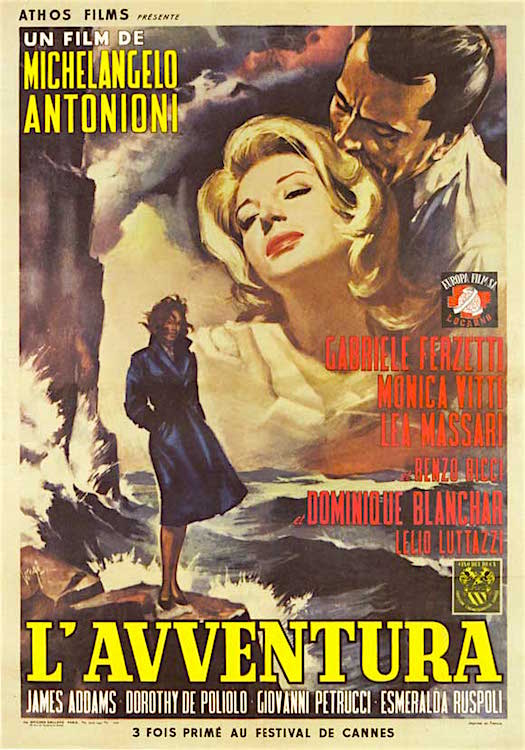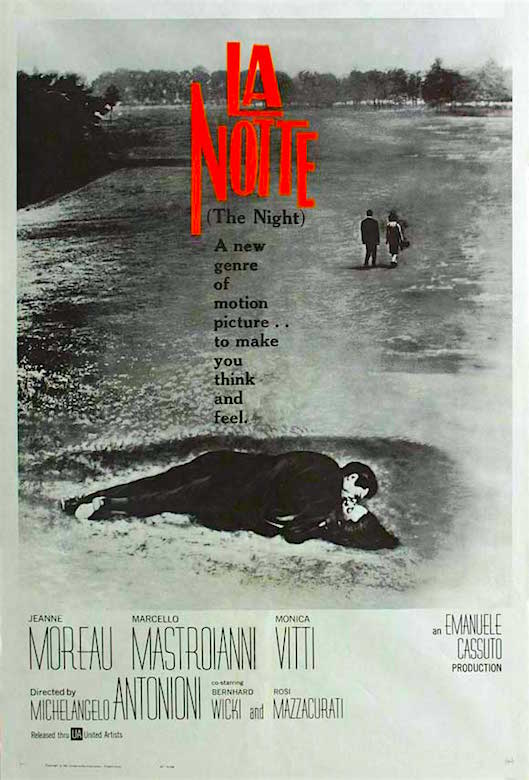““Any intelligent fool can make things bigger, more complex, and more violent. It takes a touch of genius — and a lot of courage to move in the opposite direction.”
― Ernst F. Schumacher
If ever a filmmaker has attempted to avoid moving his films in a conventional and contrived manner, it would be Benoît Jacquot. This is a film director who aims for realism without offering much in the area of character motivation or any level of explanation regarding the choices, actions and behavior of the character(s.) This mode of pursuit is not unique, but when it comes to several of Jacquot’s films it is an essential choice. This is a choice that many embrace but often more try to reject. And yet, Jacquot’s often quirkily passionate films have a way of lingering on in our memory. They should not be easily dismissed.

Pas de scandale / Keep It Quiet
Benoît Jacquet, 1999
I had just hit my 30’s when I first volunteered for both The Boston Film Festival and the then fairly newly established Boston French Film Festival. I knew a great deal about movies and was not dazed by the idea of “celebrity.” Not one to be intimidated or one to be intimidating in my communications, over a couple of years I began to be offered more interesting opportunities. Sadly, my professional life prevented me from becoming too involved. Even still these were eye-opening experiences.

Appropriately titled…
À ma soeur!
Catherine Breillat, 2001
One film that had come to the attention of both festivals was Benoît Jacquot’s Pas de scandal (or No Scandal.) Jacquot was most assuredly established within the world of International Cinema. His 1995 film, A Single Girl, which attempted to adhere to the style set forth by Agnès Varda’s Cléo from 5 to 7, had been embraced. Any discussion of A Single Girl without reference to the La Nouvelle Vague would be a crucial mistake. Another crucial aspect of Jacquot’s A Single Girl that must be mentioned is it’s complex simplicity. Virginie Ledoyen’s “Valerie” is not dealing with her immortality as Varda’s “Cleo.”
This is not to say that Valerie doesn’t have a great deal on her mind. Just starting a new and often humiliating job at a swank hotel, she is pregnant and increasingly stubborn in not wanting marriage or support from the child’s father. This independent choice is not so much a statement of Valerie’s individuality as much as it is tied to a young woman’s often irrational and immature reaction(s) to the situations into which she finds herself. She is rebellious. She is determined. She is manipulative. She can be cruel. She can be kind. She is intelligent. Most of all, she is unpredictable.

La fille seule / A Single Girl
Benoît Jacquot, 1995
As Jacquot follows Valerie throughout her first day of new employment, it is filmed in “real” time. Whatever we learn about his central character is largely limited to the way she pursues her day. And the way she pursues it does not always make logical sense. But how many of our own actions are consistently logical? This film arrived at just the right time to catch audiences attentions. The film was highly valued despite a number of production goofs. One of the main issues with A Single Girl is the low-budget style of filming on the busy streets of Paris. In more than a few scenes we see Parisians and tourists staring at the camera and small film crew. It didn’t matter, the lead actor’s presence, beauty and skill merged with Benoit Jacquot’s story and camera were a perfect match. And it wasn’t the bearing of mortality that made the film interesting. It was the often mundane interactions which Valerie often imposes an odd will and assertion that made the awkward all the more strange.
La fille seule was correctly translated to A Single Girl. It was quickly learned that the title for this film’s North American release was to be retitled Keep It Quiet. Yet another odd choice within the realm of foreign film translation to English title choices. My votes for the two most achingly bad translation titles remains Chabrol’s brilliant Merci pour le chocolat which became Night Cap and Breillat’s À ma soeur! which was changed to Fat Girl.

An inappropriate title for North American distribution…
Fat Girl
Catherine Breillat, 2001
A problematic choice to say the least, To My Sister! would have been a far more appropriate title. At the time, it almost felt like the North American distributors seemed to think that Breillat’s disturbing film was not provocative enough!?! The American title leaves an unintended extra sour taste in the mouth. Yet nothing could eclipse the brilliance of this angry and potent 2001 film. À ma soeur! or Fat Girl, an essential chapter in The New French Extreme shocks with a purpose. No title can change that. Sadly, the North American title of Night Cap assigned to Chabrol’s profoundly Hitchcockian bit of dark humor and suspense did confuse many a potential ticket buyer back in the day of its initial release. Merci pour le chocolat appeared to be a quiet and intellectual drama. It was a very poor marketing choice for one of the cinematic master’s finest later works.
However, Keep it Quiet was a surprisingly solid title translation choice for Jacquot’s strange little film. If ever a film appears to excude French culture, it is 1999’s Pas de scandal. The film is simple, yet deeply complex. It concerns a family of wealth. There is a bold honesty constantly at play, but continually muted. The characters carry intellectual, mildly quirky and stylistic personas thanks to their physicality, actions and nuanced glances. Keep It Quiet has an interesting air of sophistication, elegance, intelligence and emotional distance.

Please, whatever you do, do not cause a scene in public.
Isabelle Huppert and Fabrice Luchini do not need much in the way of dialogue to express the complex and illogical of their choices and actions.
Keep It Quiet
Benoît Jacquot, 1999
Cinematography | Romain Winding
What makes Keep It Quiet unique is that while it is all of these things, it is not verbally articulate. One of the film’s core concepts is that none of the three main characters seem to know how to communicate or even remotely articulate their respective feelings and thoughts. The result is a surprisingly charming and sad family study in which the characters act like human bumper-cars. The characters are constantly bumping into each other, but are careful to never crash. No car is completely thrown off the road. However, it is plain to see that all of them would most likely prefer that to staying the course that their respective personal choices, compulsions and obsessions have sent them speeding down an uncertain road.
Released in France and Europe as Pas de scandale (obvious meaning being No Scandal) the film fared well commercially and even better from a film criticism standpoint. But even though the film is blessed with the appearance of rightfully respected International Film Star, Isabelle Huppert, it was barely released in North America. A quick debut at The Toronto Film Festival and a very limited screening in a few major American cities, the film went unnoticed. Part of the challenge faced with marketing this highly innovative film was the fact that it avoided exploration of the transgressive. There is no real violence to speak of, a very brief scene of nudity and sexuality and none of the extremities that French Film was becoming known for a the time. And while the American title makes sense, it is hardly an attention grab.

Fabrice Luchini
Keep It Quiet
Benoît Jacquot, 1999
Cinematography | Romain Winding
Fabrice Luchini plays one of two brothers from a French family of considerable wealth and power. The eldest and more business savvy of the two, he has taken over the family business. He has been responsible in building the business into what appears to be an International Empire. Interestingly, we never learn much about the family business beyond it is powerful and creates a great deal of money. While the business has flourished under the elder brother’s leadership, he made some morally and illegal decisions that have caused him to be convicted and serve a time in prison. It is never actually stated what criminal action Gregoire Jeancourt has committed, we determine it was significant enough to cause an national scandal. One could even argue that it is unclear if Luchini’s character actually committed the crime or simply took the fall for the family.
The film begins with his first day freed from prison. Fabric Luchini sits passively with a cup of tea in a cafe. His face has a child-like level of curiosity with hints of sadness. When Isabelle Huppert enters the cafe, we see Luchini’s face light up with hope. Huppert is clearly moved, but it is unclear as to which emotional direction she is moving. Both are uncomfortable. Huppert’s Agnes presents a pleasant but fully removed presence. Yet when she starts to speak Agnes reveals there is a great deal just beneath her distant surface. It is only through an awkward bit of conversing that we realize this is Gregoire’s wife. This is the first time they have seen each other since his imprisonment and declaration of corporate guilt. Agnes’ attitude toward her husband quickly becomes a basic assumption projected onto Gregoire: he seems disoriented, confused and perhaps even a bit insane.

Sighing and lost between the struts and flirts..
Vincent Lindon
Keep It Quiet
Benoît Jacquot, 1999
Cinematography | Romain Winding
The younger brother is played by Vincent Lindon who for a never explained reason(s) was pushed out of the family business altogether excepting a share of the profits. In the meantime, Louis Jeancourt has firmly established himself as nationally admired TV Chat Show host which aims to be intellectually challenging vs. the normal exploitive aim of most popular chat shows. He has lived his live as a playboy. Ever flirting and seemingly ever uncomfortable with any level of romantic commitment. Even more odd than his sister-in-law, he appears to be more than a little uncomfortable with his elder sibling’s release from prison. Less concerned with “seeing” his brother or offering a greeting, Louis is only concerned with how the public will perceive Gregoire and their family name. Like almost every character in Gregoire’s pre-prison life, his brother thinks that there is something emotionally disturbed about his older brother.
Gregoire’s beautiful wife treats him with an icy demeanor and is more concerned with getting to her beauty salon than catching up with her husband. She is even more clear that she holds no sexual interest, when she surrenders to his sexual needs she seems shocked that his focus is more on giving pleasure than taking. No words of this brief, intimate but non-explicit scene are offered, but it seems clear that Agnes is more shocked than aroused by the experience. The husband and wife seem to constantly be in situations in which each wants to state something of emotional importance. Neither are able to do this. Never clearly stated, it would seem that Agnes remains out of duty but her husband yearns to express his love and need for her. In one of the film’s more oddly powerful moments, he tries to make his wife listen to his planned comments for an upcoming national interview. Agnes puts out that she is far too busy to sit and listen to his speech. But when it emerges that the real reason he is wants her attention is not to actually review planned statements but to offer her his personal declaration of love. When we see a bit of his interview he sits in awkward but oddly comfortable silence. Immune to the questions regarding his guilt and corporate gaul, he simply looks out as if focused on something off in the distance.

The wife and the would-be-mistress remain kind and gentle, but an undercurrent of resentment is just hanging like a vague threat above both of them.
Isabelle Huppert and Vahina Giocante
Keep It Quiet
Benoît Jacquot, 1999
Cinematography | Romain Winding
Benoit Jacquot fully employs the use of Olivier Lebé’s lush musical score. The film’s score if of import because during the first half of the film is seems in opposition to the images warmly captured by Romain Winding’s cinematography. Most of all the ambitious and gushing score seems far too musically emotive for the film’s characters and story. As the film develops toward it’s ending point this mismatched music begins to not only work, but has a schism-like impact that fits in nicely with what becomes both a passionate and cleverly intellectual film.
Gregoire may very well be having a sort of emotional break, but it is more likely that time away from his life has given him pause to reappraise his priorities. As he attempts to find a way to fit back into his life, he once again must reappraise his connections to family and his firm. There is nothing at all simple about this movie. Vincent Lindon’s Louis is deeply wounded, limited and afraid of life. He seems to hide behind his public persona to shield himself from having to significantly connect to anyone. Agnes is not the icy and distant woman she seems trying to be. Instead we begin to see that she is a loving and caring mother. We also see that while her love for her husband may be forever tarnished, there is love there. As we see she and her younger brother-in-law interact there is an increasingly uneasy feeling that their relationship has at some point taken a turn for the inappropriate. None of this is ever clearly discussed or validated, but there is a sense that Agnes’ concern for Louis goes far deeper than that of a sister-in-law. In another of the film’s most powerful moments, she and Louis meet for a cup of coffee. As Louis works up the courage to reveal a surprising truth, her intellectual reaction is both filled with humor and logic. Her physical reaction and his to her reveals something far deeper. Is her brother-in-law the actual father of one of she and Gregoires’ children? Or, is there some deeply real romantic desire between them that must remain unexplored?

Is there more here than meets the eyes?
Isabelle Huppert and Vincent Lindon
Keep It Quiet
Benoît Jacquot, 1999
Cinematography | Romain Winding
And as Gregoire’s patience with his family’s dismissal of him as disoriented or a bit insane wears thin, we see him reach out to a young woman who seems less interested than intrigued by his advances. At an uncomfortable and awkward family dinner we realize that Gregoire is far more aware of himself than others are giving him credit. He seems to prefer the company of strangers because he might find more honesty and less animosity. Jacquot’s film takes an unexpected final act twist when the wife finally steps forward with a single sentence that propels the audience to a new understanding of not only the family and the scandal: it provides us with a satisfying conclusion that explains more than it attempts to answer our questions. These actors have not just been playing characters in a story — they have slipped into the personas of the human condition. Suddenly the idea of a plot seems less important than the idea of having watched intelligent and well-intended people wandering confused through a challenging situation. Keep It Quiet is a bluntly realistic film that often pushes against ideas of logic and story-telling. Sometimes the human condition makes little sense from outside perception or even personal introspection. Nothing here is black or white. Nothing is simple, but all the complexities are presented with simple precision. Every shot of this film seems carefully planned. Benoit Jacquot has simply presented the complex.
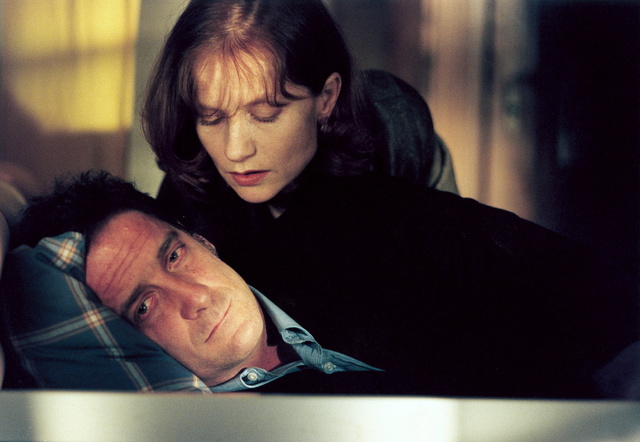
“Go after him.”
Vincent Lindon and Isabelle Huppert
Keep It Quiet
Benoît Jacquot, 1999
Cinematography | Romain Winding
Jacquot seems to be studying the unstated and the unseen. The film is at once limited within it’s own odd universe, yet is a constant reminder that these characters are not as odd as they appear. Does a spouse who has faced public ridicule and inspection due to the other spouse’s criminal activity automatically rush forward to embrace said life partner as soon as he is released from jail? Or does the experiences of dealing with a public scandal fill her with a sort of dread and discomfort at welcoming her husband home? Does the newly freed husband become angry or does this reaction cause further escalation of disorientation? Does his celebrity chat host little brother rush with open arms to his older brother who has just served a year in prison? Or like his sister-in-law, is he apprehensive and perhaps even angry for PR nightmares that the brother’s actions have caused?

Taking Existentialism to a whole other kind of level…
Fabrice Luchini
Keep It Quiet
Benoît Jacquot, 1999
Cinematography | Romain Winding
More to the point: Are all three people suddenly dropped into a disturbing situation with which none of them know how to deal? For a film with very little dialogue that deals directly with the core concerns of it’s characters, Keep It Quiet is startling revealing and confoundingly curious. And in a rare moment of clarity, the North American title translation is actually better than the French film’s original title. This is not a film about scandal or the need to hide or defend it. This is a film about human beings who are unable to open up to each other. And in some cases, even unable to open up to themselves.
After making Keep It Quiet, Benoit Jacquot seemed to turn his attention to costume or period pieces. Most notably the exquisite 2012’s Farewell My Queen, which focused on the final days prior to the French Revolution through the eyes and experiences of one of Marie Antoinette assigned court readers. This film was extremely well-crafted and garnished a great deal of praise. But in 2009, he had returned to the complicated waters of human identity with his adaptation of Pascal Quignard’s novel, Villa Amalia. A fascinating and often stunning film, this movie was primarily focused on capturing another carefully textured performance from Isabelle Huppert. Despite the costumes, eras or the cinematic intentions, all of Jacquot’s films are closely tied to the unpredictability of human nature and the often absence of logic. In September of 2014, his 3 Hearts premiered in North America at the Toronto Film Festival.

3 Hearts
Benoît Jacquot, 2014
In the past decade universally-shared languages has evolved to the point where foreign distribution to North America no longer seems to require odd “translations” for titles and improved subtitles. So much so that it made me chuckle when US distributors felt it necessary to release Jacquot’s 3 coeurs to 3 Hearts, but the title translation failed to aid the film in securing a decent US release. Despite screenings at one other US film festival, this film was largely limited to only a few larger US cities.
It is not surprising that this strange little film received mixed reviews and reactions. Despite the fact that there is a most certain connection to Leo McCarey’s 1950’s classic, An Affair to Remember, it seems many were unable to accept the idea of bizarre coincidences or odd logic to a romantic story. However, my initial response to a screening of this film last year left me somewhat conflicted. So confused was my response to 3 Hearts that it has taken me this long to comment on the strange film. It took another four viewings before I was able to clearly sort through my own issues with the film. One thing remained solidly in my mind from the first screening, this is a Benoit Jacquot movie. In fact, this might be Jacquot at his most unfettered. One should expect cinematic aspects that are both deeply complex and opposingly simple. The filmmaker is creating more than just a love story, he is playing with cinematic sensibilities without turning away from the illogic of the human condition.

A family of beautiful but strikingly different women lay at the center of this tightly-structured universe…
Chiara Mastroianni, Catherine Deneuve and Charlotte Gainsbourg
3 Hearts
Benoît Jacquot, 2014
Cinematography | Julien Hirsch
“3 Hearts” is an overtly romantic tale lensed as if it were aiming to be a psychological thriller. Bruno Coulais’ ominous musical score is an over-powering ode to Hans Zimmer’s effective score for “Inception.” Coulais’ musical score acts as a prominent character in this film. As the various production companies logos take form on the screen and the credits begin on black title cards, the almost apocalyptic warning of music starts to churn. The viewers are immediately placed off-balance with what is shown through Julien Hirsch’s cinematography.
The plot is challenging when compared to the mundane realities of life. Or is it? Many critics have complained that the “set-up” is unbelievable from the two beautiful female characters being almost obsessive in their shared love of one rather plain looking middle-aged man. This man works as a Tax Accountant played by Benoit Poelvoorde. Poelvoorde is best known to US audiences for his unforgettable turn as Ben in the low-budget Cult Film, Man Bites Dog. Certainly far from conventionally handsome, Poelvoorde has never been a gym-perfected, surgically enhanced leading man. He looks his age. Carries a bit of paunch yet manages to retain a bit of his gangley-charm. In 3 Hearts, he moves about in an almost constant state of worry. Perpetually stressed, Poelvoorde’s Marc is a bit of sweaty mess. Yet even as he fights through his panic attacks or possibly more serious heart condition, he puts forth a considerable amount of masculine charm.

Two incredibly close-knit sisters find their relationship unravel…
Charlotte Gainsbourg and Chiara Mastroianni
3 Hearts
Benoît Jacquot, 2014
Cinematography | Julien Hirsch
Several highly respected critics questioned why characters played by the likes of Charlotte Gainsbourg or Chiara Mastroianni would fall so hard for Poelvoorde’s nervous, goofy face and often comical physicality. This criticism in of itself is problematic. First and foremost, Charlotte Gainsbourg’s sexual allure and beauty are already on the wilder side of populist ideas regarding female beauty. Without question she is someone the camera loves, it is impossible to not note that she carries a good deal of androgyny. She is closer to a middle-aged Patti Smith than normal notions of cinematic beauty. This is not a bad thing. Actually, it has assisted Ms. Gainsbourg ascend to a level of cinematic success that many would have thought impossible. Typically drawn to transgressive characters, Gainsbourg has never been shy about playing out the darker corners of sexual or erotic psychology. In addition to being a highly skilled actor, she has no fear when it comes to what and how she plays a role. But like Benoit Poelvoorde, she barely fits into the idea of conventional beauty. More “hot” and “erotically-charged” than beautiful, Gainsbourg has a strong level of power on screen tinged with a little girl’s voice.

Is anyone in there?
Charlotte Gainsbourg
3 Hearts
Benoît Jacquot, 2014
Cinematography | Julien Hirsch
Chiara Mastroianni may be the real-life daughter of Catherine Deneuve and the late Marcello Mastroianni, but she has actually inherited very little of the angelic beauty of her mother or the carnal eroticism of her father. That being stated, anyone can see she is their daughter. Unlike her parents, Chiara Mastroianni has never give the impression that she was too worried about “beauty.” This is a serious actor who is not only highly skilled at what she does, she is intelligent in the way she approaches her roles. Like Gainsbourg, she is clearly comfortable with nudity and sexuality. However, I’ve never seen Ms. Mastroianni aim for provocation or even eroticism. This is an actress who plays it legit. Like her parents, she is blessed with a great deal of on-screen presence. As she has moved into her early 40’s, she brings forth a confidence that fully embraces her facial lines and moles. Certainly a beauty, she does not fit easily into the current mode of cinematic conventional beauty.

Realistic Cinematic Beauty
Charlotte Gainsbourg and Chiara Mastroianni
3 Hearts
Benoît Jacquot, 2014
Cinematography | Julien Hirsch
This of course if also why these two women stand out in the world of International Film: They do not conform to the hopelessly pathetic ideas of populist beauty. By refusing to even attempt to conform, they define the rules of their careers. Their beauty is of more natural origin, but both bring an oddly grounded level of attractiveness to the table. From this perspective, it is reasonable to state that all 3 characters (our 3 Hearts) are a cinematic idea of normal/real looking actors. Even if we should accept the assertion that these two women would never turn their head in Benoit Poelvoorde, there is something important to note:
We human beings are a complicated bunch. We make illogical choices all of the time.

Benoit Poelvoorde
3 Hearts
Benoît Jacquot, 2014
Cinematography | Julien Hirsch
And we often fall for people that may not be the “obvious” choice. In reality, we are drawn to love by far more than just looks. Peolvoorde’s “Marc” is likable, charming as well as being more than a little lost and complicated. These characteristics are pure cat-nip coming from any sex that can often become an object of desire or obsession to another.
The story is of an unhealthy man who is either dealing with heart problems or severe anxiety. He misses his train back to Paris and accidentally meets Gainsbourg’s “Sylvie” with whom he shares an almost instant attraction. Played with her typical grace and androgynously erotic charisma, the two spend the entire night talking. Somehow they fail to exchange the basic information of names, phone number and other essentials. But they make a date for later in the week. As they have no info about each other, circumstances prevent the date from being kept. Sylvie assumes she has been stood up and follows her life-partner for whom she seems to have little to no real love to live in the US.

Charlotte Gainsbourg and Benoît Poelvoorde
3 Hearts
Benoît Jacquot, 2014
Cinematography | Julien Hirsch
Soon Marc crosses paths with the plainer but more grounded, Mastroianni’s “Sophie.” This is a softer and more needy woman. Marc falls for her immediately and she quickly returns the attraction. Marc’s heart issues and panic attacks subside. It is only as they near their wedding date that Marc realizes that Sophie is Sylvie’s sister. Another plot point that seems to defy logic. There is some merit to this claim, but as the film reaches its conclusion — this plot device actually makes sense. Jacquot has stated that he employs a cinematic idea first outlined by Alfred Hitchcock in which love and scenes of love are filmed and approached like scenes of suspense. Enter the use of Bruno Coulais’ intense musical score. The film is exceptionally paced. As the romance, sexual obsessions and desperate heart-aches churn, the film’s music never lets up. A constant gush of swelling worry indicating that serious danger looms over all three characters.
Catherine Deneuve plays the sisters’ mother. She is not given much to do, but what she is given she does brilliantly. Deneuve, much like Isabelle Huppert, can say more with a glance than most actors can do with an entire page of dialogue. This is a skilled gift Deneuve has gained over almost five decades in front of the camera. Always blessed with movie star charisma and presence, over the last three decades she has become one of the most respected film actors in history. In 3 Hearts, the character of the mother serves as a sort of calming logic as well as the sole character who seems to gain insight into the dangers as they begin to unfold and upend her daughters’ happiness. When the ramifications of these dangers are revealed, it is at once dire and expected.

Is domestic bliss enough?
Benoît Poelvoorde and Chiara Mastroianni
3 Hearts
Benoît Jacquot, 2014
Cinematography | Julien Hirsch
I’ve spent some time with this film because I have felt torn regarding my opinion. I’ve reached the conclusion that my “need” to watch it more than a couple of times indicates that something within the film’s universe fascinates me. And while there is a great deal of reality at play, this film creates a very tightly constructed universe unique to itself. As both Sylvie and Sophie offer to their Marc, they are living in small country France. These comments seem to carry more meaning than simply the provincial. This is a different sort of world within which these owners of three hearts are operating. As Marc slips in his chair and his head drops in a mix of despair and pain, the musical thunder delivers us to a perplexing and somewhat confusing scene. A scene that calls the cinematic perspective into question. Like the three characters, we are left disoriented and oddly enchanted.
3 Hearts and Keep It Quiet may not be everyone’s cup of tea. Like all of this director’s films, these two fall into many of the almost hopelessly stereotypical French Cinematic Style. But I do find it difficult to believe that an Art House Film Lover will find it easy to fully dismiss or forget either of these films. There is something to be said about Benoit Jacquot’s presentation of simple choices, illogic and accidents propelling characters into a dire fates that packs more than a few punches.

Even a historical fictionalization costume dram offers a realistic depiction of humanity…
Diane Kruger as a real and very complicated Marie Antoinette
Farewell, My Queen
Benoît Jacquot, 2012
Cinematography | Romain Winding
Cinematic and odd. And ultimately Jacquot gives us an ambiguous twists. Is true happiness only a thing of dreams, chance or fate? Benoit Jacquot never fails to offer amazing insights and surprisingly strong performances.













